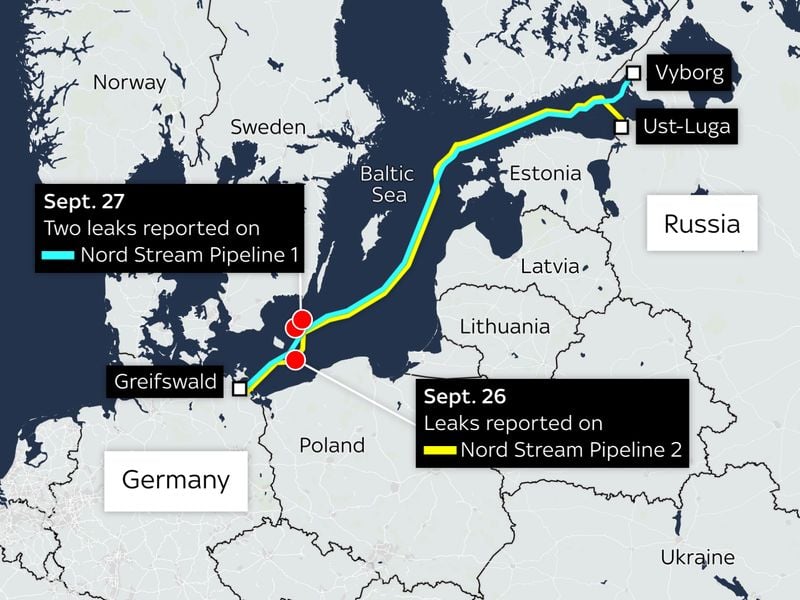The Bombing of the Nord Stream Pipeline: Who Benefits?

All Global Research articles can be read in 51 languages by activating the Translate This Article button below the author’s name.
To receive Global Research’s Daily Newsletter (selected articles), click here.
Follow us on Instagram and Twitter and subscribe to our Telegram Channel. Feel free to repost and share widely Global Research articles.
***
On Monday, powerful underwater explosions blew gaping holes in the Nord Stream 1 and 2 pipelines, which carry Russian natural gas under the Baltic Sea to Germany. Gushers of gas a kilometer in diameter are rising to the surface from the blasts, which occurred in Danish waters. Tens of billions of dollars in infrastructure vital to financing Russia’s economy, and powering and heating the German and European economy, lie in ruins.
As the US and NATO wage war against Russia in Ukraine, this event points to the reckless military escalation underway in Europe. Danish Prime Minister Mette Frederiksen said the blasts were the results of “deliberate action” by unknown parties, while Swedish seismologist Bjorn Lund said, “There’s no doubt, this is not an earthquake.”
Though European media instantly accused Russia of having bombed the Nord Stream pipelines, such charges are rapidly falling apart.
Even the New York Times, normally a source of aggressive anti-Russian propaganda, refrained from blaming the bombing on Moscow. “At first glance, it seems counterintuitive that the Kremlin would damage its own multibillion-dollar assets,” it acknowledged. “While some European officials were quick to speculate about Russian involvement, American officials were more cautious, noting the lack of available evidence,” it continued, noting that Washington “and most of its European allies stopped short of naming any suspects.”
Former Polish Foreign Minister Radek Sikorski, a member of several NATO think tanks who is married to prominent US foreign policy commentator Anne Applebaum, suggested openly that Washington was behind the bombing. He tweeted a picture of the gusher of natural gas with the label: “Thank you, USA.” He added, “Now $20 billion of scrap metal lies at the bottom of the sea, another cost to Russia of its criminal decision to invade Ukraine.”
Accusations of Russian involvement in the bombings lack all credibility and detract from the far more likely perpetrator: the United States. The first question that has to be asked about the Nord Stream bombing is: Cui bono? Who benefits, and who had the motive to carry it out?
Russia had no motive to destroy the Nord Stream pipeline. Russia’s Gazprom conglomerate owned half of the pipeline, alongside German, French and Dutch shareholders, and the pipeline was at the heart of Moscow’s plans to rebuild economic ties with Europe, if and when the war with NATO in Ukraine ended. It had no reason to blow up its own pipeline.
For Washington, the bombing presented two benefits. Firstly, coming amid the NATO military escalation against Russia in Ukraine, it would help fuel more anti-Russian war propaganda. Secondly, by making Europe more dependent on US natural gas imports to replace Russian gas, it corresponded to a major US aim in the Ukraine war from the outset: to bring Europe more firmly under US control. These aims have increasingly come into the open in recent years.
In 2018, bitter conflicts erupted between the Trump administration and Berlin, as Trump slapped sanctions on German car exports to America and demanded Berlin shut down Nord Stream 2.
On February 7, 2022, as he stepped up economic and military threats against the Kremlin before the Russia invasion of Ukraine, US President Joe Biden invited German Chancellor Olaf Scholz to Washington for talks. During a joint press conference with Scholz, Biden pledged to destroy the Nord Stream 2 pipeline. “If Russia invades,” Biden said, “then there will be no longer a Nord Stream 2. We will bring an end to it.”
Asked how he would do this—as the Nord Stream pipeline is jointly owned by Russia and ostensible NATO allies of the United States such as Germany, France and the Netherlands—Biden refused to answer, simply saying: “I promise you, we will be able to do that.”
The Stalinist bureaucracy’s dissolution of the Soviet Union in 1991 not only paved the way for NATO to wage bloody imperialist wars from Iraq and Yugoslavia to Afghanistan, Libya and Syria. It deprived NATO of its main enemy, which had helped unify the alliance, and threw Eurasia open to major US and European corporations. Tensions between the NATO imperialist powers, as they competed for the division of the spoils of the world economy, exploded.
Trump demanded that Berlin end Nord Stream 2 after it called for an EU military buildup and a defense policy independent from NATO. While then-German Chancellor Angela Merkel called for Germany to “fight for our own future ourselves,” French President Emmanuel Macron called for the EU to prepare to confront Russia, China or America.
EU officials rejected Trump’s calls to end Nord Stream 2. Such demands, said German lawmaker Rolf Mützenich, “affect German and European companies and represent interference in our internal affairs. The EU and Germany are apparently not allied partners for Trump, but tributary vassals…”
The US policy towards Europe recalls Leon Trotsky’s warning, nearly a century ago, that in a period of crisis “the hegemony of the United States will operate more completely, more openly, and more ruthlessly than in the period of boom.” Trotsky described US imperialism’s plans for Europe after World War I as follows:
It will slice up the markets; it will regulate the activity of the European financiers and industrialists. If we wish to give a clear and precise answer to the question of what American imperialism wants, we must say: It wants to put capitalist Europe on rations.
This concisely describes Washington’s policy today. This year, it seized upon Russia’s invasion of Ukraine to escalate the war with Russia and impose the cutoff of EU energy trade with Russia that it had long sought. The impact on Europe is devastating.
Millions of workers in Europe face the prospect of freezing this winter, with gas prices surging tenfold as Europe replaces cheap Russian gas transported by pipeline with US liquefied natural gas. The price hikes are further magnified as European currencies fall against the US dollar, which is rising as the US Federal Reserve increases its interest rates. European steel, chemical and other companies, the Wall Street Journal noted, “are shifting operations to the U.S., attracted by more stable energy prices and muscular government support.”
The EU imperialists have agreed to this, insofar as the war is a pretext to keep diverting billions of euros to rearmament. The German bourgeoisie in particular aims, after losing two world wars, to re-emerge as Europe’s leading military power. This month Scholz called for Germany to “become the cornerstone of conventional defence in Europe, the best-equipped force in Europe” and demanded a German seat on the UN Security Council.
While Berlin officially ended its support for Nord Stream 2 after the Russian invasion, it is raising the issue of renewed energy ties with Russia. This week, Merkel said one should never lose sight of “the day after.” She called to think about what is “sheerly unimaginable at the moment—namely, how something like relations towards and with Russia can be developed again.”
It is more credible to explain the Nord Stream attack, not as an act of economic and political suicide by Russia, but as a signal sent by Washington to its EU “allies”: “Yes, you can re-militarize, but your energy and military policy will be set on our terms.”
These conflicts make all the more clear the enormous dangers facing masses of workers and youth as NATO and Russia teeter on the edge of an all-out global conflagration.
*
Note to readers: Please click the share buttons above or below. Follow us on Instagram and Twitter and subscribe to our Telegram Channel. Feel free to repost and share widely Global Research articles.
Featured image is from InfoBrics


No comments:
Post a Comment